Point groups in three dimensions
 Involutional symmetry Cs, (*) [ ] = |
 Cyclic symmetry Cnv, (*nn) [n] = |
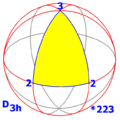 Dihedral symmetry Dnh, (*n22) [n,2] = | |
| Polyhedral group, [n,3], (*n32) | |||
|---|---|---|---|
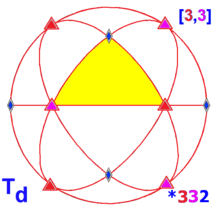 Tetrahedral symmetry Td, (*332) [3,3] = |
 Octahedral symmetry Oh, (*432) [4,3] = |
 Icosahedral symmetry Ih, (*532) [5,3] = | |
In geometry, a point group in three dimensions is an isometry group in three dimensions that leaves the origin fixed, or correspondingly, an isometry group of a sphere. It is a subgroup of the orthogonal group O(3), the group of all isometries that leave the origin fixed, or correspondingly, the group of orthogonal matrices. O(3) itself is a subgroup of the Euclidean group E(3) of all isometries.
Symmetry groups of objects are isometry groups. Accordingly, analysis of isometry groups is analysis of possible symmetries. All isometries of a bounded 3D object have one or more common fixed points. We choose the origin as one of them.
The symmetry group of an object is sometimes also called full symmetry group, as opposed to its rotation group or proper symmetry group, the intersection of its full symmetry group and the rotation group SO(3) of the 3D space itself. The rotation group of an object is equal to its full symmetry group if and only if the object is chiral.
The point groups in three dimensions are heavily used in chemistry, especially to describe the symmetries of a molecule and of molecular orbitals forming covalent bonds, and in this context they are also called molecular point groups.
Finite Coxeter groups are a special set of point groups generated purely by a set of reflectional mirrors passing through the same point. A rank n Coxeter group has n mirrors and is represented by a Coxeter–Dynkin diagram. Coxeter notation offers a bracketed notation equivalent to the Coxeter diagram, with markup symbols for rotational and other subsymmetry point groups.
Group structure
SO(3) is a subgroup of E+(3), which consists of direct isometries, i.e., isometries preserving orientation; it contains those that leave the origin fixed.
O(3) is the direct product of SO(3) and the group generated by inversion (denoted by its matrix −I):
- O(3) = SO(3) × { I , −I }
Thus there is a 1-to-1 correspondence between all direct isometries and all indirect isometries, through inversion. Also there is a 1-to-1 correspondence between all groups of direct isometries H in O(3) and all groups K of isometries in O(3) that contain inversion:
- K = H × { I , −I }
- H = K ∩ SO(3)
For instance, if H is C2, then K is C2h, or if H is C3, then K is S6. (See lower down for the definitions of these groups.)
If a group of direct isometries H has a subgroup L of index 2, then, apart from the corresponding group containing inversion there is also a corresponding group that contains indirect isometries but no inversion:
- M = L ∪ ( (H ∖ L) × { −I } )
where isometry ( A, I ) is identified with A. An example would be C4 for H and S4 for M.
Thus M is obtained from H by inverting the isometries in H ∖ L. This group M is as abstract group isomorphic with H. Conversely, for all isometry groups that contain indirect isometries but no inversion we can obtain a rotation group by inverting the indirect isometries. This is clarifying when categorizing isometry groups, see below.
In 2D the cyclic group of k-fold rotations Ck is for every positive integer k a normal subgroup of O(2,R) and SO(2,R). Accordingly, in 3D, for every axis the cyclic group of k-fold rotations about that axis is a normal subgroup of the group of all rotations about that axis. Since any subgroup of index two is normal, the group of rotations (Cn) is normal both in the group obtained by adding reflections in planes through the axis (Cnv) and in the group obtained by adding a reflection plane perpendicular to the axis (Cnh).
3D isometries that leave origin fixed
The isometries of R3 that leave the origin fixed, forming the group O(3,R), can be categorized as follows:
- SO(3,R):
- identity
- rotation about an axis through the origin by an angle not equal to 180°
- rotation about an axis through the origin by an angle of 180°
- the same with inversion (x is mapped to −x), i.e. respectively:
- inversion
- rotation about an axis by an angle not equal to 180°, combined with reflection in the plane through the origin perpendicular to the axis
- reflection in a plane through the origin
The 4th and 5th in particular, and in a wider sense the 6th also, are called improper rotations.
See also the similar overview including translations.
Conjugacy
When comparing the symmetry type of two objects, the origin is chosen for each separately, i.e. they need not have the same center. Moreover, two objects are considered to be of the same symmetry type if their symmetry groups are conjugate subgroups of O(3) (two subgroups H1, H2 of a group G are conjugate, if there exists g ∈ G such that H1 = g−1H2g ).
For example, two 3D objects have the same symmetry type:
- if both have mirror symmetry, but with respect to a different mirror plane
- if both have 3-fold rotational symmetry, but with respect to a different axis.
In the case of multiple mirror planes and/or axes of rotation, two symmetry groups are of the same symmetry type if and only if there is a rotation mapping the whole structure of the first symmetry group to that of the second. (In fact there will be more than one such rotation, but not an infinite number as when there is only one mirror or axis.) The conjugacy definition would also allow a mirror image of the structure, but this is not needed, the structure itself is achiral. For example, if a symmetry group contains a 3-fold axis of rotation, it contains rotations in two opposite directions. (The structure is chiral for 11 pairs of space groups with a screw axis.)
Infinite isometry groups
There are many infinite isometry groups; for example, the "cyclic group" (meaning that it is generated by one element – not to be confused with a torsion group) generated by a rotation by an irrational number of turns about an axis. We may create non-cyclical abelian groups by adding more rotations around the same axis. There are also non-abelian groups generated by rotations around different axes. These are usually (generically) free groups. They will be infinite unless the rotations are specially chosen.
All the infinite groups mentioned so far are not closed as topological subgroups of O(3). We now discuss topologically closed subgroups of O(3).

The whole O(3) is the symmetry group of spherical symmetry; SO(3) is the corresponding rotation group. The other infinite isometry groups consist of all rotations about an axis through the origin, and those with additionally reflection in the planes through the axis, and/or reflection in the plane through the origin, perpendicular to the axis. Those with reflection in the planes through the axis, with or without reflection in the plane through the origin perpendicular to the axis, are the symmetry groups for the two types of cylindrical symmetry. Note that any physical object having infinite rotational symmetry will also have the symmetry of mirror planes through the axis.
Finite isometry groups
Symmetries in 3D that leave the origin fixed are fully characterized by symmetries on a sphere centered at the origin. For finite 3D point groups, see also spherical symmetry groups.
Up to conjugacy the set of finite 3D point groups consists of:
- 7 infinite series with at most one more-than-2-fold rotation axis; they are the finite symmetry groups on an infinite cylinder, or equivalently, those on a finite cylinder. They are sometimes called the axial or prismatic point groups.
- 7 point groups with multiple 3-or-more-fold rotation axes; they can also be characterized as point groups with multiple 3-fold rotation axes, because all 7 include these axes; with regard to 3-or-more-fold rotation axes the possible combinations are:
- 4 3-fold axes
- 4 3-fold axes and 3 4-fold axes
- 10 3-fold axes and 6 5-fold axes
A selection of point groups is compatible with discrete translational symmetry: 27 from the 7 infinite series, and 5 of the 7 others, the 32 so-called crystallographic point groups. See also the crystallographic restriction theorem.
The seven infinite series of axial groups
The infinite series of axial or prismatic groups have an index n, which can be any integer; in each series, the nth symmetry group contains n-fold rotational symmetry about an axis, i.e. symmetry with respect to a rotation by an angle 360°/n. n=1 covers the cases of no rotational symmetry at all. There are four series with no other axes of rotational symmetry (see cyclic symmetries) and three with additional axes of 2-fold symmetry (see dihedral symmetry). They can be understood as point groups in two dimensions extended with an axial coordinate and reflections in it. They are related to the frieze groups;[1] they can be interpreted as frieze-group patterns repeated n times around a cylinder.
The following table lists several notations for point groups: Hermann–Mauguin notation (used in crystallography), Schönflies notation (used to describe molecular symmetry), orbifold notation, and Coxeter notation. The latter three are not only conveniently related to its properties, but also to the order of the group. It is a unified notation, also applicable for wallpaper groups and frieze groups. The crystallographic groups have n restricted to 1, 2, 3, 4, and 6; removing crystallographic restriction allows any positive integer. The series are:
| H–M | Schön. | Orb. | Cox. | Frieze | Struct. (Order) |
Example | Comments | |
|---|---|---|---|---|---|---|---|---|
| Even n | Odd n | (cylinder) | ||||||
| n | Cn | nn | [n]+ | p1 | Zn (n) | n-fold rotational symmetry | ||
| 2n | n | S2n | n× | [2n+,2+] | p11g | Z2n (2n) | n-fold rotoreflection symmetry Not to be confused with the abstract symmetric group | |
| n/m | 2n | Cnh | n* | [n+,2] | p11m | Zn×Dih1 (2n) | ||
| nmm | nm | Cnv | *nn | [n] | p1m1 | Dihn (2n) | Pyramidal symmetry; in biology, biradial symmetry | |
| n22 | n2 | Dn | 22n | [n,2]+ | p211 | Dihn (2n) | Dihedral symmetry | |
| 2n2m | nm | Dnd | 2*n | [2n,2+] | p2mg | Dih2n (4n) | Antiprismatic symmetry | |
| n/mmm | 2n2m | Dnh | *22n | [n,2] | p2mm | Dihn×Dih1 (4n) | Prismatic symmetry | |
For odd n we have Z2n = Zn × Z2 and Dih2n = Dihn × Dih1.
The terms horizontal (h) and vertical (v), and the corresponding subscripts, refer to the additional mirror plane, that can be parallel to the rotation axis (vertical) or perpendicular to the rotation axis (horizontal).
The simplest nontrivial ones have Involutional symmetry (abstract group Z2 or Dih1):
- Ci – inversion symmetry
- C2 – 2-fold rotational symmetry
- Cs – reflection symmetry, also called bilateral symmetry.
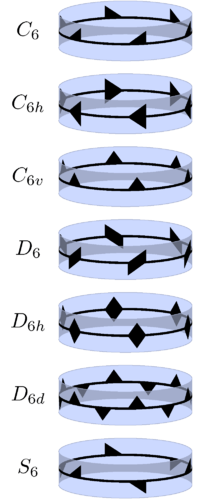
The second of these is the first of the uniaxial groups (cyclic groups) Cn of order n (also applicable in 2D), which are generated by a single rotation of angle 360°/n. In addition to this, one may add a mirror plane perpendicular to the axis, giving the group Cnh of order 2n, or a set of n mirror planes containing the axis, giving the group Cnv, also of order 2n. The latter is the symmetry group for a regular n-sided pyramid. A typical object with symmetry group Cn or Dn is a propeller.
If both horizontal and vertical reflection planes are added, their intersections give n axes of rotation through 180°, so the group is no longer uniaxial. This new group of order 4n is called Dnh. Its subgroup of rotations is the dihedral group Dn of order 2n, which still has the 2-fold rotation axes perpendicular to the primary rotation axis, but no mirror planes. Note that in 2D Dn includes reflections, which can also be viewed as flipping over flat objects without distinction of front- and backside, but in 3D the two operations are distinguished: the group contains "flipping over", not reflections.
There is one more group in this family, called Dnd (or Dnv), which has vertical mirror planes containing the main rotation axis, but instead of having a horizontal mirror plane, it has an isometry that combines a reflection in the horizontal plane and a rotation by an angle 180°/n. Dnh is the symmetry group for a regular (n+2)-sided prisms and also for a regular (2n)-sided bipyramid. Dnd is the symmetry group for a regular (n+2)-sided antiprism, and also for a regular (2n)-sided trapezohedron. Dn is the symmetry group of a partially rotated prism.
The groups D2 and D2h are noteworthy in that there is no special rotation axis. Rather, there are three perpendicular 2-fold axes. D2 is a subgroup of all the polyhedral symmetries (see below), and D2h is a subgroup of the polyhedral groups Th and Oh. D2 can occur in homotetramers such as Concanavalin A, in tetrahedral coordination compounds with four identical chiral ligands, or in a molecule such as tetrakis(chlorofluoromethyl)methane if all the chlorofluoromethyl groups have the same chirality. The elements of D2 are in 1-to-2 correspondence with the rotations given by the unit Lipschitz quaternions.
The group Sn is generated by the combination of a reflection in the horizontal plane and a rotation by an angle 360°/n. For n odd this is equal to the group generated by the two separately, Cnh of order 2n, and therefore the notation Sn is not needed; however, for n even it is distinct, and of order n. Like Dnd it contains a number of improper rotations without containing the corresponding rotations.
All symmetry groups in the 7 infinite series are different, except for the following four pairs of mutually equal ones:
- C1h and C1v: group of order 2 with a single reflection (Cs )
- D1 and C2: group of order 2 with a single 180° rotation
- D1h and C2v: group of order 4 with a reflection in a plane and a 180° rotation through a line in that plane
- D1d and C2h: group of order 4 with a reflection in a plane and a 180° rotation through a line perpendicular to that plane
S2 is the group of order 2 with a single inversion (Ci )
"Equal" is meant here as the same up to conjugacy in space. This is stronger than "up to algebraic isomorphism". For example, there are three different groups of order two in the first sense, but there is only one in the second sense. Similarly, e.g. S2n is algebraically isomorphic with Z2n.
The groups may be constructed as follows:
- Cn. Generated by an element also called Cn, which corresponds to a rotation by angle 2π/n around the axis. Its elements are E (the identity), Cn, Cn2, ..., Cnn−1, corresponding to rotation angles 0, 2π/n, 4π/n, ..., 2(n − 1)π/n.
- S2n. Generated by element C2nσh, where σh is a reflection in the direction of the axis. Its elements are the elements of Cn with C2nσh, C2n3σh, ..., C2n2n−1σh added.
- Cnh. Generated by element Cn and reflection σh. Its elements are the elements of group Cn, with elements σh, Cnσh, Cn2σh, ..., Cnn−1σh added.
- Cnv. Generated by element Cn and reflection σv in a direction in the plane perpendicular to the axis. Its elements are the elements of group Cn, with elements σv, Cnσv, Cn2σv, ..., Cnn−1σv added.
- Dn. Generated by element Cn and 180° rotation U = σhσv around a direction in the plane perpendicular to the axis. Its elements are the elements of group Cn, with elements U, CnU, Cn2U, ..., Cnn − 1U added.
- Dnd. Generated by elements C2nσh and σv. Its elements are the elements of group Cn and the additional elements of S2n and Cnv, with elements C2nσhσv, C2n3σhσv, ..., C2n2n − 1σhσv added.
- Dnh. Generated by elements Cn, σh, and σv. Its elements are the elements of group Cn and the additional elements of Cnh, Cnv, and Dn.
Taking n to ∞ yields groups with continuous axial rotations:
| H–M | Schönflies | Orbifold | Coxeter | Limit of | Abstract group | ||
|---|---|---|---|---|---|---|---|
| ∞ | C∞ | ∞∞ | [∞]+ | Cn | Z∞ | SO(2) | |
| ∞, ∞/m | C∞h | ∞* | [2,∞+] | Cnh, S2n | Dih1×Z∞ | Z2×SO(2) | |
| ∞m | C∞v | *∞∞ | [∞] | Cnv | Dih∞ | O(2) | |
| ∞2 | D∞ | 22∞ | [2,∞]+ | Dn | Dih∞ | O(2) | |
| ∞m, ∞/mm | D∞h | *22∞ | [2,∞] | Dnh, Dnd | Dih1×Z∞ | Z2×O(2) | |
The seven remaining point groups
The remaining point groups are said to be of very high or polyhedral symmetry because they have more than one rotation axis of order greater than 2. Here, Cn denotes an axis of rotation through 360°/n and Sn denotes an axis of improper rotation through the same. In parentheses are the orbifold notation, Coxeter notation (Coxeter diagram), the full Hermann–Mauguin notation, and the abbreviated one if different. The groups are:
| T, (332) [3,3]+ ( 23 order 12 | chiral tetrahedral symmetry | There are four C3 axes, each through two vertices of a cube (body diagonals) or one of a regular tetrahedron, and three C2 axes, through the centers of the cube's faces, or the midpoints of the tetrahedron's edges. This group is isomorphic to A4, the alternating group on 4 elements, and is the rotation group for a regular tetrahedron. It is a normal subgroup of Td, Th, and the octahedral symmetries. The elements of the group correspond 1-to-2 to the rotations given by the 24 unit Hurwitz quaternions (the "binary tetrahedral group"). |
| Td, (*332) [3,3] ( 43m order 24 | full tetrahedral symmetry | This group has the same rotation axes as T, but with six mirror planes, each containing two edges of the cube or one edge of the tetrahedron, a single C2 axis and two C3 axes. The C2 axes are now actually S4 axes. This group is the symmetry group for a regular tetrahedron. Td is isomorphic to S4, the symmetric group on 4 letters, because there is a 1-to-1 correspondence between the elements of Td and the 24 permutations of the four 3-fold axes. An object of C3v symmetry under one of the 3-fold axes gives rise under the action of Td to an orbit consisting of four such objects, and Td corresponds to the set of permutations of these four objects. Td is a normal subgroup of Oh. See also the isometries of the regular tetrahedron. |
| Th, (3*2) [3+,4] ( 2/m3, m3 order 24 | pyritohedral symmetry | 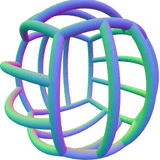 The seams of a volleyball have Th symmetry. |
| O, (432) [4,3]+ ( 432 order 24 | chiral octahedral symmetry | This group is like T, but the C2 axes are now C4 axes, and additionally there are 6 C2 axes, through the midpoints of the edges of the cube. This group is also isomorphic to S4 because its elements are in 1-to-1 correspondence to the 24 permutations of the 3-fold axes, as with T. An object of D3 symmetry under one of the 3-fold axes gives rise under the action of O to an orbit consisting of four such objects, and O corresponds to the set of permutations of these four objects. It is the rotation group of the cube and octahedron. Representing rotations with quaternions, O is made up of the 24 unit Hurwitz quaternions and the 24 Lipschitz quaternions of squared norm 2 normalized by dividing by . As before, this is a 1-to-2 correspondence. |
| Oh, (*432) [4,3] ( 4/m32/m, m3m order 48 | full octahedral symmetry | This group has the same rotation axes as O, but with mirror planes, comprising both the mirror planes of Td and Th. This group is isomorphic to S4 × Z2 (because both O and Ci are normal subgroups), and is the symmetry group of the cube and octahedron. See also the isometries of the cube. |
| I, (532) [5,3]+ ( 532 order 60 | chiral icosahedral symmetry | the rotation group of the icosahedron and the dodecahedron. It is a normal subgroup of index 2 in the full group of symmetries Ih. The group contains 10 versions of D3 and 6 versions of D5 (rotational symmetries like prisms and antiprisms). It also contains five versions of T (see Compound of five tetrahedra). The group I is isomorphic to A5, the alternating group on 5 letters, since its elements correspond 1-to-1 with even permutations of the five Th symmetries (or the five tetrahedra just mentioned). Representing rotations with quaternions, I is made up of the 120 unit icosians. As before, this is a 1-to-2 correspondence. |
| Ih, (*532) [5,3] ( 532/m, 53m order 120 | full icosahedral symmetry | the symmetry group of the icosahedron and the dodecahedron. The group Ih is isomorphic to A5 × Z2 because I and Ci are both normal subgroups. The group contains 10 versions of D3d, 6 versions of D5d (symmetries like antiprisms), and 5 versions of Th. |
The continuous groups related to these groups are:
As noted above for the infinite isometry groups, any physical object having K symmetry will also have Kh symmetry.
Relation between orbifold notation and order
The order of each group is 2 divided by the orbifold Euler characteristic; the latter is 2 minus the sum of the feature values, assigned as follows:
- n without or before * counts as (n−1)/n
- n after * counts as (n−1)/(2n)
- * and × count as 1
This can also be applied for wallpaper groups and frieze groups: for them, the sum of the feature values is 2, giving an infinite order; see orbifold Euler characteristic for wallpaper groups
Reflective Coxeter groups
| A3, [3,3], |
B3, [4,3], |
H3, [5,3], |
|---|---|---|
 6 mirrors |
 3+6 mirrors |
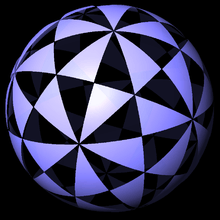 15 mirrors |
| 2A1, [1,2], |
3A1, [2,2], |
A1A2, [2,3], |
 2 mirrors |
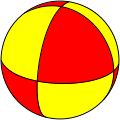 3 mirrors |
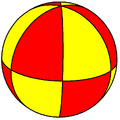 4 mirrors |
| A1, [1], |
2A1, [2], |
A2, [3], |
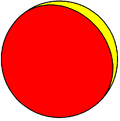 1 mirror |
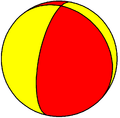 2 mirrors |
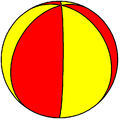 3 mirrors |
The reflective point groups in three dimensions are also called Coxeter groups and can be given by a Coxeter-Dynkin diagram and represent a set of mirrors that intersect at one central point, and bound a spherical triangle domain on the surface of a sphere. Coxeter groups with less than 3 generators have degenerate spherical triangle domains, as lunes or a hemisphere. In Coxeter notation these groups are tetrahedral symmetry [3,3], octahedral symmetry [4,3], icosahedral symmetry [5,3], and dihedral symmetry [p,2]. The number of mirrors for an irreducible group is nh/2, where h is the Coxeter group's Coxeter number, n is the dimension (3).[2]
| Weyl group |
Coxeter notation |
Order | Coxeter number (h) |
Mirrors (m) | |
|---|---|---|---|---|---|
| Polyhedral groups | |||||
| A3 | [3,3] | 24 | 4 | 6 | |
| B3 | [4,3] | 48 | 6 | 3+6 | |
| H3 | [5,3] | 120 | 10 | 15 | |
| Dihedral groups | |||||
| 2A1 | [1,2] | 4 | 1+1 | ||
| 3A1 | [2,2] | 8 | 2+1 | ||
| I2(p)A1 | [p,2] | 4p | p+1 | ||
| Cyclic groups | |||||
| 2A1 | [2] | 4 | 2 | ||
| I2(p) | [p] | 2p | p | ||
| Single mirror | |||||
| A1 | [ ] | 2 | 1 | ||
Rotation groups
The rotation groups, i.e. the finite subgroups of SO(3), are: the cyclic groups Cn (the rotation group of a canonical pyramid), the dihedral groups Dn (the rotation group of a uniform prism, or canonical bipyramid), and the rotation groups T, O and I of a regular tetrahedron, octahedron/cube and icosahedron/dodecahedron.
In particular, the dihedral groups D3, D4 etc. are the rotation groups of plane regular polygons embedded in three-dimensional space, and such a figure may be considered as a degenerate regular prism. Therefore, it is also called a dihedron (Greek: solid with two faces), which explains the name dihedral group.
- An object with symmetry group Cn, Cnh, Cnv or S2n has rotation group Cn.
- An object with symmetry group Dn, Dnh, or Dnd has rotation group Dn.
- An object with one of the other seven symmetry groups has as rotation group the corresponding one without subscript: T, O or I.
The rotation group of an object is equal to its full symmetry group if and only if the object is chiral. In other words, the chiral objects are those with their symmetry group in the list of rotation groups.
Given in Schönflies notation, Coxeter notation, (orbifold notation), the rotation subgroups are:
| Reflection | Reflection/rotational | Improper rotation | Rotation |
|---|---|---|---|
| Cnv, [n], (*nn) | Cnh, [n+,2], (n*) | S2n, [2n+,2+], (n×) | Cn, [n]+, (nn) |
| Dnh, [2,n], (*n22) | Dnd, [2+,2n], (2*n) | Dn, [2,n]+, (n22) | |
| Td, [3,3], (*332) | T, [3,3]+, (332) | ||
| Oh, [4,3], (*432) | Th, [3+,4], (3*2) | O, [4,3]+, (432) | |
| Ih, [5,3], (*532) | I, [5,3]+, (532) | ||
Correspondence between rotation groups and other groups
The following groups contain inversion:
- Cnh and Dnh for even n
- S2n and Dnd for odd n (S2 = Ci is the group generated by inversion; D1d = C2h)
- Th, Oh, and Ih
As explained above, there is a 1-to-1 correspondence between these groups and all rotation groups:
- Cnh for even n and S2n for odd n correspond to Cn
- Dnh for even n and Dnd for odd n correspond to Dn
- Th, Oh, and Ih correspond to T, O, and I, respectively.
The other groups contain indirect isometries, but not inversion:
- Cnv
- Cnh and Dnh for odd n
- S2n and Dnd for even n
- Td
They all correspond to a rotation group H and a subgroup L of index 2 in the sense that they are obtained from H by inverting the isometries in H \ L, as explained above:
- Cn is subgroup of Dn of index 2, giving Cnv
- Cn is subgroup of C2n of index 2, giving Cnh for odd n and S2n for even n
- Dn is subgroup of D2n of index 2, giving Dnh for odd n and Dnd for even n
- T is subgroup of O of index 2, giving Td
Maximal symmetries
There are two discrete point groups with the property that no discrete point group has it as proper subgroup: Oh and Ih. Their largest common subgroup is Th. The two groups are obtained from it by changing 2-fold rotational symmetry to 4-fold, and adding 5-fold symmetry, respectively. Alternatively the two groups are generated by adding for each a reflection plane to Th.
There are two crystallographic point groups with the property that no crystallographic point group has it as proper subgroup: Oh and D6h. Their maximal common subgroups, depending on orientation, are D3d and D2h.
The groups arranged by abstract group type
Below the groups explained above are arranged by abstract group type.
The smallest abstract groups that are not any symmetry group in 3D, are the quaternion group (of order 8), Z3 × Z3 (of order 9), the dicyclic group Dic3 (of order 12), and 10 of the 14 groups of order 16.
The column "# of order 2 elements" in the following tables shows the total number of isometry subgroups of types C2, Ci, Cs. This total number is one of the characteristics helping to distinguish the various abstract group types, while their isometry type helps to distinguish the various isometry groups of the same abstract group.
Within the possibilities of isometry groups in 3D, there are infinitely many abstract group types with 0, 1 and 3 elements of order 2, there are two with 2n + 1 elements of order 2, and there are three with 2n + 3 elements of order 2 (for each n ≥ 2 ). There is never a positive even number of elements of order 2.
Symmetry groups in 3D that are cyclic as abstract group
The symmetry group for n-fold rotational symmetry is Cn; its abstract group type is cyclic group Zn, which is also denoted by Cn. However, there are two more infinite series of symmetry groups with this abstract group type:
- For even order 2n there is the group S2n (Schoenflies notation) generated by a rotation by an angle 180°/n about an axis, combined with a reflection in the plane perpendicular to the axis. For S2 the notation Ci is used; it is generated by inversion.
- For any order 2n where n is odd, we have Cnh; it has an n-fold rotation axis, and a perpendicular plane of reflection. It is generated by a rotation by an angle 360°/n about the axis, combined with the reflection. For C1h the notation Cs is used; it is generated by reflection in a plane.
Thus we have, with bolding of the 10 cyclic crystallographic point groups, for which the crystallographic restriction applies:
| Order | Isometry groups | Abstract group | # of order 2 elements | Cycle diagram |
|---|---|---|---|---|
| 1 | C1 | Z1 | 0 | |
| 2 | C2, Ci, Cs | Z2 | 1 | |
| 3 | C3 | Z3 | 0 | |
| 4 | C4, S4 | Z4 | 1 | |
| 5 | C5 | Z5 | 0 | |
| 6 | C6, S6, C3h | Z6 = Z3 × Z2 | 1 | |
| 7 | C7 | Z7 | 0 | |
| 8 | C8, S8 | Z8 | 1 | |
| 9 | C9 | Z9 | 0 | |
| 10 | C10, S10, C5h | Z10 = Z5 × Z2 | 1 |
etc.
Symmetry groups in 3D that are dihedral as abstract group
In 2D dihedral group Dn includes reflections, which can also be viewed as flipping over flat objects without distinction of front- and backside.
However, in 3D the two operations are distinguished: the symmetry group denoted by Dn contains n 2-fold axes perpendicular to the n-fold axis, not reflections. Dn is the rotation group of the n-sided prism with regular base, and n-sided bipyramid with regular base, and also of a regular, n-sided antiprism and of a regular, n-sided trapezohedron. The group is also the full symmetry group of such objects after making them chiral by e.g. an identical chiral marking on every face, or some modification in the shape.
The abstract group type is dihedral group Dihn, which is also denoted by Dn. However, there are three more infinite series of symmetry groups with this abstract group type:
- Cnv of order 2n, the symmetry group of a regular n-sided pyramid
- Dnd of order 4n, the symmetry group of a regular n-sided antiprism
- Dnh of order 4n for odd n. For n = 1 we get D2, already covered above, so n ≥ 3.
Note the following property:
- Dih4n+2 Dih2n+1 × Z2
Thus we have, with bolding of the 12 crystallographic point groups, and writing D1d as the equivalent C2h:
| Order | Isometry groups | Abstract group | # of order 2 elements | Cycle diagram |
|---|---|---|---|---|
| 4 | D2, C2v, C2h | Dih2 = Z2 × Z2 | 3 | |
| 6 | D3, C3v | Dih3 | 3 | |
| 8 | D4, C4v, D2d | Dih4 | 5 | |
| 10 | D5, C5v | Dih5 | 5 | |
| 12 | D6, C6v, D3d, D3h | Dih6 = Dih3 × Z2 | 7 | |
| 14 | D7, C7v | Dih7 | 7 | |
| 16 | D8, C8v, D4d | Dih8 | 9 | |
| 18 | D9, C9v | Dih9 | 9 | |
| 20 | D10, C10v, D5h, D5d | Dih10 = D5 × Z2 | 11 |
etc.
Other
C2n,h of order 4n is of abstract group type Z2n × Z2. For n = 1 we get Dih2, already covered above, so n ≥ 2.
Thus we have, with bolding of the 2 cyclic crystallographic point groups:
| Order | Isometry group | Abstract group | # of order 2 elements | Cycle diagram |
|---|---|---|---|---|
| 8 | C4h | Z4 × Z2 | 3 | |
| 12 | C6h | Z6 × Z2 = Z3 × Z22 = Z3 × Dih2 | 3 | |
| 16 | C8h | Z8 × Z2 | 3 | |
| 20 | C10h | Z10 × Z2 = Z5 × Z22 = Z5 × Dih2 | 3 |
etc.
Dnh of order 4n is of abstract group type Dihn × Z2. For odd n this is already covered above, so we have here D2nh of order 8n, which is of abstract group type Dih2n × Z2 (n≥1).
Thus we have, with bolding of the 3 dihedral crystallographic point groups:
| Order | Isometry group | Abstract group | # of order 2 elements | Cycle diagram |
|---|---|---|---|---|
| 8 | D2h | Dih2 × Z2 | 7 | |
| 16 | D4h | Dih4 × Z2 | 11 | |
| 24 | D6h | Dih6 × Z2 = Dih3 × Z22 | 15 | |
| 32 | D8h | Dih8 × Z2 | 19 |
etc.
The remaining seven are, with bolding of the 5 crystallographic point groups (see also above):
| Order | Isometry group | Abstract group | # of order 2 elements | Cycle diagram |
|---|---|---|---|---|
| 12 | T | A4 | 3 | |
| 24 | Td, O | S4 | 6 | |
| 24 | Th | A4 × Z2 | 6 | |
| 48 | Oh | S4 × Z2 | 6 | |
| 60 | I | A5 | ||
| 120 | Ih | A5 × Z2 |
Fundamental domain
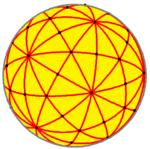 |
 |
| The planes of reflection for icosahedral symmetry intersect the sphere on great circles, with right spherical triangle fundamental domains | |
The fundamental domain of a point group is a conic solid. An object with a given symmetry in a given orientation is characterized by the fundamental domain. If the object is a surface it is characterized by a surface in the fundamental domain continuing to its radial bordal faces or surface. If the copies of the surface do not fit, radial faces or surfaces can be added. They fit anyway if the fundamental domain is bounded by reflection planes.
For a polyhedron this surface in the fundamental domain can be part of an arbitrary plane. For example, in the disdyakis triacontahedron one full face is a fundamental domain of icosahedral symmetry. Adjusting the orientation of the plane gives various possibilities of combining two or more adjacent faces to one, giving various other polyhedra with the same symmetry. The polyhedron is convex if the surface fits to its copies and the radial line perpendicular to the plane is in the fundamental domain.
Also the surface in the fundamental domain may be composed of multiple faces.
Binary polyhedral groups
The map Spin(3) → SO(3) is the double cover of the rotation group by the spin group in 3 dimensions. (This is the only connected cover of SO(3), since Spin(3) is simply connected.) By the lattice theorem, there is a Galois connection between subgroups of Spin(3) and subgroups of SO(3) (rotational point groups): the image of a subgroup of Spin(3) is a rotational point group, and the preimage of a point group is a subgroup of Spin(3).
The preimage of a finite point group is called a binary polyhedral group, represented as <l,n,m>, and is called by the same name as its point group, with the prefix binary, with double the order of the related polyhedral group (l,m,n). For instance, the preimage of the icosahedral group (2,3,5) is the binary icosahedral group, <2,3,5>.
The binary polyhedral groups are:
- : binary cyclic group of an (n + 1)-gon, order 2n
- : binary dihedral group of an n-gon, <2,2,n>, order 4n
- : binary tetrahedral group, <2,3,3>, order 24
- : binary octahedral group, <2,3,4>, order 48
- : binary icosahedral group, <2,3,5>, order 120
These are classified by the ADE classification, and the quotient of C2 by the action of a binary polyhedral group is a Du Val singularity.[3]
For point groups that reverse orientation, the situation is more complicated, as there are two pin groups, so there are two possible binary groups corresponding to a given point group.
Note that this is a covering of groups, not a covering of spaces – the sphere is simply connected, and thus has no covering spaces. There is thus no notion of a "binary polyhedron" that covers a 3-dimensional polyhedron. Binary polyhedral groups are discrete subgroups of a Spin group, and under a representation of the spin group act on a vector space, and may stabilize a polyhedron in this representation – under the map Spin(3) → SO(3) they act on the same polyhedron that the underlying (non-binary) group acts on, while under spin representations or other representations they may stabilize other polyhedra.
This is in contrast to projective polyhedra – the sphere does cover projective space (and also lens spaces), and thus a tessellation of projective space or lens space yields a distinct notion of polyhedron.
See also
Footnotes
- ↑ Fisher, G.L.; Mellor, B. (2007), "Three-dimensional finite point groups and the symmetry of beaded beads" (PDF), Journal of Mathematics and the Arts
- ↑ Coxeter, Regular polytopes', §12.6 The number of reflections, equation 12.61
- ↑ Du Val Singularities, by Igor Burban
References
- Coxeter, H. S. M. (1974), "7 The Binary Polyhedral Groups", Regular Complex Polytopes, Cambridge University Press, pp. 73–82 .
- Coxeter, H. S. M. & Moser, W. O. J. (1980). Generators and Relations for Discrete Groups, 4th edition. New York: Springer-Verlag. ISBN 0-387-09212-9. 6.5 The binary polyhedral groups, p. 68
- Conway, John Horton; Huson, Daniel H. (2002), "The Orbifold Notation for Two-Dimensional Groups", Structural Chemistry, Springer Netherlands, 13 (3): 247–257, doi:10.1023/A:1015851621002
External links
- Graphic overview of the 32 crystallographic point groups – form the first parts (apart from skipping n=5) of the 7 infinite series and 5 of the 7 separate 3D point groups
- Overview of properties of point groups
- Simplest Canonical Polyhedra of Each Symmetry Type (uses Java)
- Point Groups and Crystal Systems, by Yi-Shu Wei, pp. 4–6
- The Geometry Center: 10.1 Formulas for Symmetries in Cartesian Coordinates (three dimensions)